Made with ❤️ in Florida
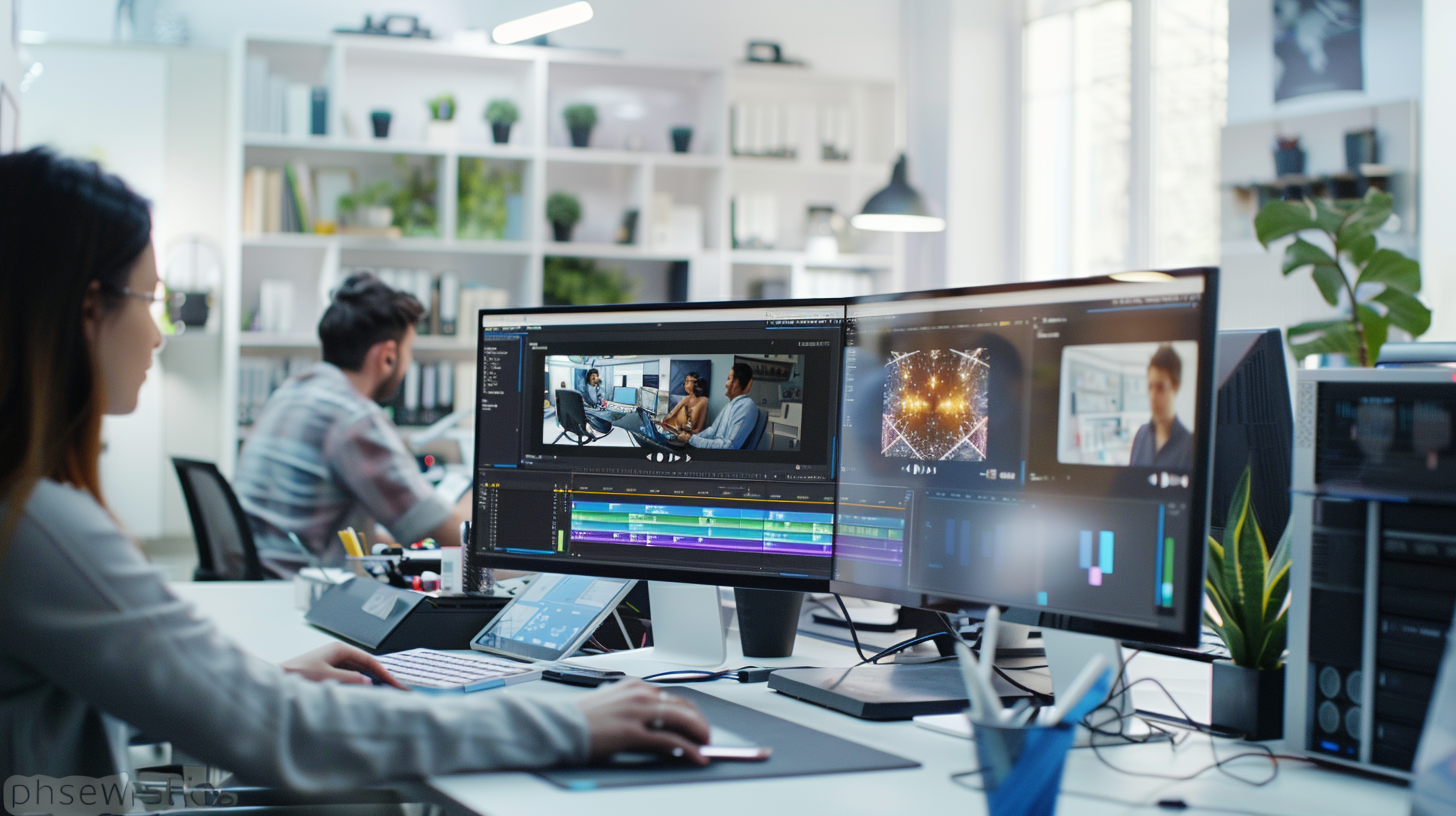
Video marketing has come a long way, evolving from simple TV commercials to dynamic online content that captures audience attention. Now, with the advent of AI in video production, the landscape is shifting once again. How can AI tools speed up the creation process and enhance the quality and customization of your videos? This article will explore these questions, providing insights into the benefits and practical applications of AI in video marketing.

Traditional video production traditionally began with the simultaneous recording of video and embedded audio. This initial audio, often captured on location or during the shoot, would frequently be replaced or enhanced during post-production using Automated Dialogue Replacement (ADR). However, the advent of AI video production has ushered in a new era where videos are constructed without this embedded audio serving as a primary reference. Surprisingly, this fusion of audio and video, which we perhaps took for granted, formed the cornerstone of both editing and post-production workflows. We now face the challenge of reconstructing this foundational backbone from scratch. This post aims to shed light on how to establish a new structural flow for video editing, one that maintains the rhythm and natural essence of the content. In essence, the task is to ensure that video and audio synchronize harmoniously. To achieve this, our first step is to define the audio narrative, followed by the video creation. When dealing with clips that already contain an audio script, our approach involves integrating these pieces into our audio editing framework. Subsequently, this allows us to craft the visual elements, incorporate AI avatars, special effects, and more, ensuring a cohesive and engaging final product. The evolution of video production from traditional methods to the innovative use of artificial intelligence marks a pivotal shift in how we create and consume media. The Backbone of AI Video Production For years, the seamless sync of audiovisual content was a given, with cameras capturing both elements in a single take. However, AI video production challenges us to reimagine this process. The key? Starting with the audio. This paradigm shift requires us to engineer the emotional arc, rhythm, and pivotal moments of the audio first, which then serves as the guiding light for the visual storytelling. Crafting the Narrative Start with the Score : The first step in this dance is to script the audio. This script isn't just dialogue or sound effects; it's the emotional core of your piece. It dictates the rhythm, highlights key moments, and sets the overall tone for the narrative. Piece Together the Puzzle : With an audio script in hand, we can begin to arrange visual elements. If you have clips with embedded audio, these become invaluable assets. Align these visual building blocks with the flow of your audio narrative, filling any gaps with additional sound elements to create a cohesive story. Paint with Pixels : With our sonic foundation laid, the visual creation process begins. This stage is about choosing shots, integrating AI avatars, and applying effects that amplify the audio. It's a delicate balance, ensuring that each visual element enhances the audio narrative. Breathe Life into It : The final step is where your editing skills truly shine. This stage involves refining pacing, adjusting timing, and perfecting transitions to ensure a seamless marriage between audio and visual elements. The goal is to create an engaging experience that feels natural and emotionally compelling. The Benefits and Challenges This approach not only grants creators unprecedented creative freedom but also demands a new level of finesse and innovation. The benefits are clear: videos that immerse viewers in a sensory journey, where every sight and sound is meticulously crafted to resonate on a deeper level. However, embracing this new method comes with its challenges. The shift to defining audio first can be daunting, requiring a rethink of traditional editing workflows. Seamlessly integrating existing clips into this new structure also tests one's editing prowess. Yet, for those willing to explore the boundaries of AI video production, the rewards are storytelling at its most impactful. As we venture further into the realm of AI-driven content creation, our methods and techniques will continue to evolve. This exploration of audio-led video production is just the beginning. It opens up a world of possibilities for crafting narratives that engage, inspire, and resonate. We're on the cusp of a new frontier in storytelling. I invite you to join this journey, experimenting with these techniques and sharing your insights. How do you see AI transforming video production? What challenges and opportunities do you foresee? Let's discuss in the comments below and pioneer this exciting landscape together. P.S. This exploration is merely the starting point. As AI technology advances, so too will our strategies for weaving audio and visuals into compelling stories. Stay tuned for more insights into the tools and techniques that will define the future of video production.

In today's digital marketplace, the fusion of AI video technology with your business's data and tech stack isn't just an advantage—it's a necessity. Across industries of all sizes, the power to captivate, educate, and engage through AI video is transforming the landscape of customer interaction and content creation. This extensive blog post explores 20 groundbreaking opportunities where AI video can be the catalyst for transformation and growth. From revitalizing testimonials with AI avatars to crafting dynamic, personalized marketing campaigns, each example delves into how these technologies are not just shaping the future—they are defining it. Businesses are no longer bound by the constraints of traditional video production. AI avatars can now deliver testimonials, bringing a human touch to digital endorsements. Automated sales videos offer a personalized follow-up that was once only possible with a live team. Service summaries, once mundane, now become engaging recaps with AI-generated overviews. These 20 examples aren't just ideas; they are beacons that showcase the potential of AI video to enhance engagement, simplify complex processes, and open up new opportunities for businesses of every size. They matter because, in the digital age, staying ahead means embracing innovation and making it work for you. For each example, we will discuss the application, its benefits, and why it could be a crucial step for businesses looking to innovate and lead in their industry. Whether it's improving customer experience, streamlining operations, or ensuring compliance, these AI video integrations can provide significant value and a competitive edge. Let's dive into each example and uncover why they're game-changers for businesses worldwide. 20 Example AI Video Use Cases Use Case 1 — AI Avatar Testimonial Videos: Transform text-based testimonials into engaging talking head AI avatar videos for website integration and email marketing enhancements. AI Avatar Testimonial Videos are a transformative tool for any business. This innovative application turns written praise into compelling video content, making your customer's words come alive through AI avatars. The benefits are manifold: Enhanced Engagement: Videos captivate attention far more effectively than text, keeping potential customers on your page longer. Emotional Connection: Avatars can convey emotions through facial expressions and tone, resonating more deeply with viewers. Versatile Integration: Easily embed these videos on your website or include them in emails, enhancing your marketing reach. Consistency: AI avatars provide a consistent brand image and message across various platforms. Cost-Efficiency: Save on production costs associated with traditional video testimonials while maintaining high quality. For businesses looking to innovate and stand out, AI Avatar Testimonial Videos are more than just a technological advancement; they're a step towards a more engaging and emotionally connected customer experience. Use Case 2 — Automated AI Sales Videos: Create AI-generated videos with virtual versions of salespeople for personalized follow-ups in email responses post-sales call. Automated AI Sales Videos revolutionize how businesses follow up after sales calls. These AI-generated videos feature virtual salespeople, delivering a personalized touch to email follow-ups. They respond to client inquiries, provide additional information, or thank customers for their time, all while maintaining a personal and engaging connection. This technology not only elevates the customer experience but also streamlines the sales process, ensuring consistent and efficient communication. By adopting these AI sales videos, businesses can stay ahead, offering a memorable service that could be a game-changer in customer relations and sales conversion. Personalized Engagement: Utilize AI to create virtual salesperson videos that deliver personalized follow-ups after sales calls. Consistent Brand Voice: Ensure a consistent brand message and tone across all communications with AI-generated sales avatars. Efficient Follow-Up: Streamline the follow-up process with automated video messages that address each client's specific needs and queries. Enhanced Email Responses: Transform standard email follow-ups into engaging, visual communications that stand out in your clients' inboxes. Scalable Personalization: Offer a tailored touch at scale, as AI allows for customization without the need for individual recording sessions. Use Case 3 — Service Summary Videos: Enable service technicians to take before-and-after repair pictures, automatically generating summary overview videos for customer and management review. Service Summary Videos elevate customer trust and loyalty for businesses offering service and repair work. They also serve as a digital log, enhancing the service team's accountability and quality assurance. For managers, these videos enable quick reviews, streamlining oversight and replacing lengthy report writing. Enhanced Transparency: Customers see the value of the service provided through a visual transformation. Improved Communication: Complex services are easily explained, increasing customer understanding and satisfaction. Efficiency in Reporting: Saves time for technicians and management by automating the creation of professional review videos. Use Case 4 — Transforming Old Content into New: Update and repurpose old video content, such as refreshing an outdated online course, utilizing AI to modernize and enhance the material for current audiences. In the realm of digital content, relevance is king. As technology evolves, so too must the media that businesses use to educate, engage, and connect with their audience. Refreshing outdated content is not just about staying current; it's about reinvigorating the connection with your audience and ensuring your message continues to resonate in an ever-changing digital landscape. Revitalization: AI can inject new life into old videos, keeping your brand's message fresh and relevant. Modernization: Outdated online courses can be updated with AI, enhancing the learning experience for today’s audience. Engagement: Renewed content means renewed interest, helping you to maintain a strong connection with your viewers. Cost-Effectiveness: Repurposing content with AI is a smart investment, circumventing the need for entirely new productions. Consistency: Ensure your entire content library reflects the current state of your industry and brand image. Use Case 5 — Interactive FAQ Videos: Create dynamic, AI-hosted FAQ sections where avatars provide personalized answers to common questions, improving customer engagement and reducing support tickets. These dynamic FAQ sections not only modernize customer interaction but also streamline operations, making them an essential tool for businesses aiming to innovate and excel in customer experience. Interactive FAQ Videos are a cutting-edge solution to enhance customer service and engagement. Here's why integrating AI-hosted FAQ sections can be a game-changer: Personalized Customer Support: AI avatars offer tailored responses to common questions, providing a personalized touch to customer service. Reduced Support Tickets: By answering frequently asked questions through interactive videos, businesses can decrease the number of routine support tickets. 24/7 Availability: AI avatars are available around the clock, ensuring that customer inquiries are addressed at any time, improving overall satisfaction. Cost Efficiency: Automating responses to common questions can significantly reduce customer service costs. Consistency in Answers: AI ensures that the information provided is consistent, accurate, and up-to-date, maintaining brand reliability. Use Case 6 — Product Launch and Feature Updates: Utilize AI avatars to introduce new products or feature updates, making announcements more engaging and informative. Using AI avatars for product launches and updates not only modernizes how you communicate with your audience but also streamlines your marketing efforts and enriches customer experience. Introducing new products or feature updates with AI avatars adds a dynamic edge to your announcements. Here's how this approach can revolutionize your product launches: Engaging Introductions: AI avatars can capture attention with lifelike animations and speech, creating an interactive experience for product reveals. In-Depth Explanations: Avatars can provide detailed explanations of features, benefits, and uses in a conversational manner, making complex information easily digestible. Consistent Messaging: Ensure brand consistency with avatars delivering your updates in a uniform tone and style, reflecting your company's image. Cost-Effective Updates: Reduce the need for costly video shoots with AI-generated updates that can be created and edited quickly. Scalability: Easily scale your video production for different products, features, and markets without additional resources. Use Case 7 — Employee Training and Onboarding Videos: Develop customizable training modules for employees, featuring AI-branded avatars that guide viewers through processes, policies, and product use. Incorporating AI into employee training and onboarding processes marks a significant step towards efficient and engaging education within the workplace. Customizable AI-driven training modules allow new hires to interact with brand-specific avatars, making the learning process more intuitive and personal. Tailored Learning Experience: AI facilitates the creation of training content that is adapted to the pace and learning style of each employee. Consistent Training Quality: AI-branded avatars ensure that the training quality is uniform across all modules, maintaining high standards. Interactive Education: Interactive elements within the videos engage employees actively, leading to better retention of information. On-Demand Availability: AI-driven modules are available anytime, providing flexible learning opportunities. Scalability: As the business grows, the training content can be easily scaled to accommodate more employees without additional resources. Cost-Effectiveness: Reduces the need for in-person training sessions, cutting down on training costs. AI-powered training videos represent an innovative approach to employee development, offering an engaging, cost-effective, and scalable solution for modern businesses. Use Case 8 — Event Summaries and Highlights: Automatically generate summary videos of events, conferences, or webinars, incorporating key moments, speeches, and attendee feedback. In the digital age, where content is king, the ability to quickly produce concise and captivating summaries of live events is invaluable. AI technology can capture the essence of events, from global conferences to local webinars, and present it in a format that's not only informative but also highly shareable. Such summaries serve as an essential tool for those unable to attend or for attendees who wish to revisit the highlights. Quick Turnaround: AI swiftly processes hours of footage to extract and compile key moments into a digestible format. Comprehensive Coverage: Ensures all significant speeches, discussions, and reactions are highlighted. Engagement and Reach: Summary videos can be shared across social platforms, extending the event's reach post-conclusion. Value Addition: Provides attendees and non-attendees with a valuable resource for reflection or catch-up. Feedback Integration: Incorporates real attendee feedback to showcase authentic reactions and takeaways. Marketing Asset: These summaries act as promotional material for future events, demonstrating the value and dynamism of the event experience. AI-driven event summary videos are not just a record of what was; they are a bridge to what could be, for future attendees and the host organization. They encapsulate the energy and insights of the event in a way that is both engaging and accessible. Use Case 9 — Personalized Sales and Marketing Messages: Craft personalized video messages for leads or customers, featuring an AI avatar that addresses them by name and references their specific interests or needs. The power of personalization in sales and marketing cannot be overstated. With the advent of AI technology, businesses can now create personalized video messages that speak directly to an individual lead or customer, addressing them by name and catering to their unique preferences or requirements. This strategy is proven to increase engagement, build stronger customer relationships, and drive sales. Highly Targeted Communication: AI analyzes customer data to create messages that resonate on a personal level. Scalable Personalization: Even with a large customer base, AI enables the personalization of video messages at scale. Increased Engagement: Personalized messages stand out in a crowded market, making customers feel valued and heard. Enhanced Customer Experience: Recognizing a customer’s specific needs or interests significantly enhances their experience with the brand. Improved Conversion Rates: Personalization leads to higher conversion rates as messages are more relevant to the receiver. Customer Retention: By making customers feel special and understood, personalized messages can foster loyalty and encourage repeat business. By leveraging AI for personalized sales and marketing messages, companies can create a distinctive and memorable brand experience that not only attracts but retains customers over time. Use Case 10 — Customer Journey Highlights: Craft videos that map out the customer journey, showcasing key interactions and milestones with your brand, personalized for individual clients using AI. Creating videos that highlight the customer journey can significantly enhance the customer experience by visually demonstrating the value and touchpoints your brand offers. AI makes it possible to personalize these videos for individual clients, ensuring that the content is highly relevant and engaging. This approach not only illustrates the customer's progress and milestones but also reinforces the ongoing relationship between the customer and the brand. Personalized Storytelling: AI helps in creating a narrative that is unique to each customer's journey, making them feel valued and understood. Visual Milestones: Showcases the key moments and interactions that a customer has with the brand, providing a visual representation of their experience. Enhanced Engagement: Personalized content is more likely to capture and retain the customer's attention, increasing engagement and brand loyalty. Customer Appreciation: Such videos can act as a form of appreciation, acknowledging the customer's journey and commitment to the brand. Data-Driven Personalization: AI utilizes data to customize the journey highlights accurately, ensuring that the content is relevant to each customer. Feedback Loop: These videos can serve as a feedback mechanism, showing customers that their interactions are noticed and valued, and can encourage further engagement. AI-powered customer journey videos are an innovative way to connect with clients on a personal level, fostering a deeper emotional investment in the brand and enhancing customer satisfaction. Use Case 11 — Virtual Event Recaps: Utilize AI to create engaging recaps of virtual events, highlighting key speakers, topics, and audience reactions, providing value even to those who couldn't attend. AI technology offers a dynamic way to encapsulate the essence of virtual events in succinct, engaging recaps. This innovative approach ensures that the key takeaways and the spirit of the event are effectively communicated, offering an inclusive experience for those unable to participate live. By leveraging AI for event recaps, organizations can extend the lifespan of their events, broadening their impact and accessibility. Highlight Reel: AI can identify and compile the most impactful moments and quotes from speakers, ensuring viewers receive the most valuable content. Audience Insights: Analyze audience engagement data to feature popular segments or topics that resonated the most with live participants. Time-Efficient: Provides a quick yet comprehensive overview of the event, perfect for social media sharing or email summaries. Increased Reach: Recaps can be shared with a wider audience, increasing the event's visibility and extending its reach beyond the initial broadcast. Post-Event Engagement: Keeps the conversation going post-event, encouraging continued discussion and interaction with the content. Memory Preservation: Acts as a digital memento for attendees and a promotional piece for future events. AI-driven virtual event recaps serve as a strategic tool to maximize the return on investment for virtual events, ensuring the insights and engagements they generate continue to add value long after the event has concluded. Use Case 12 — Interactive Product Demos: Design AI-powered interactive product demos where viewers can choose what features they want to learn more about, creating a customized viewing experience. In the digital marketplace, interactive product demos are essential for engaging potential customers. By leveraging AI, companies can create dynamic video demonstrations that respond to user interactions, providing a deeper dive into the features that interest them most. This tailored approach not only educates consumers about the product but also makes the experience more relevant and personal. Customer-Centric Approach: Allows viewers to select their path within the product demo, focusing on what's most relevant to them. Increased Engagement: Interactive elements keep viewers involved and interested, potentially leading to longer viewing times and a better understanding of the product. Better Lead Qualification: Viewer choices during the demo provide valuable insights into what features are most appealing to potential customers. Enhanced Learning: Customers can learn at their own pace, rewinding or skipping as needed, which can lead to higher satisfaction and confidence in their purchase decision. Direct Feedback Loop: The way viewers interact with the demo can offer direct feedback on which features to highlight or improve upon. Scalable Personalization: AI can scale the interactive experience to countless viewers, each with a personalized journey through the product's features. Creating interactive product demos with AI is more than just showcasing a product; it’s about delivering a personalized educational journey that can lead to increased customer satisfaction and sales conversions. Use Case 13 — Localization of Marketing Videos: Automatically adapt marketing videos for different regions, including translations, cultural adjustments, and localized branding, enhancing global reach. The globalization of marketing has made it essential for businesses to resonate with diverse audiences worldwide. The localization of marketing videos is more than just translating the language; it involves tailoring content to reflect the cultural nuances, values, and preferences of each target region. This strategy ensures that the marketing message is not only understood but also culturally relevant, increasing its effectiveness. Cultural Relevance: Ensures that video content is appropriate and resonates with the local culture, traditions, and values. Language Accessibility: Translations and subtitles make videos accessible to a wider audience, breaking language barriers. Brand Consistency: Maintains the core brand message while making necessary adjustments for local markets, ensuring a consistent brand identity. Market Penetration: Localized content can significantly increase market penetration and brand acceptance in new regions. Customer Connection: By reflecting local languages and cultures, businesses can foster a stronger emotional connection with their audience. Competitive Advantage: Companies that effectively localize their content can stand out in the global market and gain an edge over competitors. Localization is a key component of a global marketing strategy, allowing businesses to effectively communicate with international audiences and build a loyal customer base across borders. Use Case 14 — Augmented Reality (AR) Experiences: Incorporate AR into videos, allowing customers to visualize products in their own space, enhancing interactivity and engagement. Incorporating AR into video content is not just about staying on top of trends; it’s about providing a value-added service that enriches the customer journey and sets a brand apart in a competitive marketplace. Augmented Reality is revolutionizing the way customers interact with products before making a purchase. By integrating AR into marketing videos, businesses can offer an immersive experience that allows customers to see how products would look and fit in their own environment. This interactive form of engagement not only captures the interest of potential buyers but also significantly aids in their decision-making process. Interactive Visualization: AR allows customers to place virtual products in their real-life environment, providing a realistic sense of size, scale, and design. Enhanced Engagement: By making video content interactive, viewers are encouraged to actively participate rather than passively watch, increasing engagement levels. Improved Conversion Rates: Customers are more likely to make a purchase after experiencing products in AR, as it reduces the uncertainty of online shopping. Reduced Return Rates: With a better understanding of the product through AR, customers make more informed decisions, leading to fewer returns. Innovative Brand Image: Utilizing AR technology positions a brand as a forward-thinking leader in digital innovation. Customized Experiences: AR can be tailored to individual customer preferences and behaviors, creating a personalized shopping experience. Use Case 15 — Behind-the-Scenes Content Creation: Use AI to generate behind-the-scenes footage for products or services, giving customers insight into the creation process and company values. In an era where authenticity is highly valued by customers, AI-generated behind-the-scenes content serves as a powerful engagement tool. It allows businesses to peel back the curtain and share the intricacies of their creation process, reinforcing their brand values and building a deeper connection with their audience. This not only enhances transparency but also adds a layer of storytelling to the brand narrative. Authentic Engagement: Offers a genuine look at the product or service creation, fostering trust and a stronger customer-brand relationship. Educational Insight: Educates customers on the craftsmanship, effort, and technology that go into making a product or service. Brand Storytelling: Humanizes the brand by sharing stories of the people and processes behind it, making the company more relatable. Exclusive Content: Provides content that customers can’t get elsewhere, adding value to the overall customer experience. Customer Loyalty: Behind-the-scenes content can lead to increased customer loyalty as consumers feel more connected to the brand. Marketing Differentiator: Sets the brand apart from competitors by showcasing unique aspects of the creation process that others are not sharing. Through the strategic use of AI, businesses can efficiently create behind-the-scenes content that resonates with their audience, offering a transparent view that aligns with their brand message and values. Use Case 16 — AI-Generated News Summaries: Produce daily or weekly news summary videos on relevant industry topics, personalized for your audience's interests. These AI-driven summaries are more than just a convenience; they are a transformative tool for businesses to maintain a pulse on industry trends and engage with their audience on a deeper level. AI-Generated News Summaries bring a cutting edge to staying informed and current in any industry. They are not just a technological novelty but a strategic asset for businesses aiming to keep their audience engaged with the latest updates personalized to their interests. Customized Content: AI tailors news summaries to match the interests of your specific audience, making each video relevant and engaging. Time-Efficient Updates: Daily or weekly summaries ensure your audience stays informed without the overwhelm of continuous news streams. Engagement Booster: By providing condensed, essential information, these summaries keep viewers returning for more insights, boosting regular engagement. Brand Authority: Regular, informed updates position your business as a thought leader in your industry. Data-Driven Insights: The AI's ability to analyze viewer preferences can help refine content strategies over time for maximum impact. Use Case 17 — Customer Onboarding Videos: Create custom onboarding video sequences for new customers, using AI to tailor the content based on their specific product or service usage. Custom onboarding videos revolutionize the new customer experience by leveraging AI to create personalized introductions to your services or products. These tailored sequences resonate with clients, as they receive content that reflects their specific interactions and needs. Here's how these videos can transform customer onboarding: Personalized Approach: Each video is crafted to the customer's journey, making them feel valued from day one. Streamlined Onboarding: Simplifies the learning process, providing a clear understanding of the product or service. Higher Engagement: Interactive and AI-customized content keeps the customer interested and engaged. Brand Consistency: Maintains a consistent brand voice and message, reinforcing brand identity. Scalable Solutions: Effortlessly expands to accommodate an increasing number of new customers without extra workload. Use Case 18 — Dynamic Video Advertisements: Generate video ads that dynamically change based on viewer data, such as location, browsing history, or past purchases, for highly targeted marketing. By generating video ads that dynamically adapt to viewer data, businesses can create a marketing experience that is not only more engaging but also more effective at driving sales and brand loyalty. Dynamic Video Advertisements have the power to transform the marketing experience for both businesses and consumers. Here’s why they are becoming an indispensable part of targeted marketing strategies: Highly Personalized Content: Dynamic ads can tailor content in real-time based on viewer data, making each advertisement highly relevant to the individual watching it. Improved Engagement: Personalized ads are more engaging and can lead to higher conversion rates as they resonate more with viewers' interests and behaviors. Efficient Use of Data: Leveraging data such as location, browsing history, or past purchases allows businesses to optimize their marketing efforts and budget. Enhanced Customer Experience: Providing content that viewers find useful and relevant improves their overall experience with the brand. Scalability: This approach allows for scalability in advertising, reaching a broad audience while maintaining a personalized touch. Use Case 19 — User-Generated Content Compilation: Automate the compilation of user-generated content into promotional videos, showcasing real customers and their experiences. Incorporating UGC through AI video integrations can transform how businesses connect with their audience, making it a crucial strategy for those looking to lead in their industry. Leveraging user-generated content (UGC) reflects a brand's authenticity and fosters a strong community. Here's how AI can enhance this: Automated Compilation: AI swiftly compiles UGC into compelling promotional videos, saving time and resources. Showcase Real Experiences: Authentic customer stories and experiences are highlighted, enhancing trust in the brand. Increased Engagement: Videos with real customer content tend to engage more viewers, leading to increased social sharing and brand visibility. Personalized Campaigns: AI can personalize UGC compilations for targeted demographics, increasing relevance and impact. Scalable Content Creation: As the volume of UGC grows, AI can scale video production to match, ensuring a steady stream of fresh, relatable content. Use Case 20 — Milestone Celebrations: Create personalized videos celebrating customer milestones or anniversaries with your service, fostering loyalty and engagement. Milestone videos are more than just a thank you; they're a powerful tool for building lasting loyalty and turning customers into brand advocates. Celebrating milestones with personalized AI videos is a unique and memorable way to honor the loyalty of your customers. Here's why it's an essential strategy: Deepens Customer Relationships: Tailored videos commemorating a customer's milestone with your service foster a deep, personal connection. Boosts Customer Retention: Personalized recognition encourages continued engagement, increasing the likelihood of customer retention. Enhances Brand Image: Celebratory videos show that your company values its customers, enhancing your brand's image and reputation. Encourages Social Sharing: Customers are likely to share these personalized videos, providing you with free, authentic marketing. Drives Engagement: Celebrating customer milestones can lead to higher engagement rates on your digital platforms. Bonus Use Case — Virtual Real Estate Tours: Offer AI-driven virtual tours for real estate listings, incorporating voiceovers and interactive elements to enhance the buying experience. Virtual Real Estate Tours using AI technology not only elevate the property viewing experience but also signify a leap towards digital innovation in the real estate industry, providing a valuable tool for agents and a convenient option for buyers. In the fast-paced real estate market, AI-driven virtual tours stand out by offering potential buyers an immersive viewing experience from the comfort of their own home. Here's how these virtual tours can transform the real estate industry: Engaging Presentations: Virtual tours with AI narration provide a compelling showcase of properties, keeping potential buyers engaged and interested. Interactive Elements: Buyers can interact with different elements of the property, such as opening doors or viewing 360-degree angles, for a comprehensive virtual visit. Convenience: AI-driven tours can be accessed anytime, removing scheduling constraints and opening the property to a wider audience. Cost-Effective: These tours save realtors time and money by reducing the need for in-person showings without compromising on the quality of the buyer's experience. Competitive Advantage: Offering advanced virtual tours can set a real estate listing apart, attracting more views and potentially faster sales. As we reflect on the diverse array of AI video use cases explored in this blog post, it's evident that the intersection of artificial intelligence and video technology is not just reshaping industries but also redefining the boundaries of innovation and creativity. From enhancing customer engagement through personalized content to revolutionizing healthcare with advanced diagnostics, AI video technologies offer a glimpse into a future where digital experiences are more immersive, intuitive, and impactful. This exploration serves as a beacon for businesses and creators alike, urging them to leverage these technologies to foster growth, drive efficiency, and create unparalleled user experiences. The journey through the 20 AI video use cases illustrates the versatility and potential of AI to transform mundane tasks into extraordinary opportunities for connection and exploration. It highlights the importance of adapting to these technological advancements not as a challenge but as a vital step towards staying competitive in a rapidly evolving digital landscape. Moreover, it underscores the necessity for ethical considerations and responsible innovation as we navigate this uncharted territory, ensuring that the benefits of AI video technologies are accessible and equitable across all sectors of society. In conclusion, the promise of AI video technology is boundless, poised to unlock new dimensions of human creativity and ingenuity. As we stand on the precipice of this technological evolution, the call to action is clear: to embrace these advancements with an open mind and a visionary outlook. By doing so, we can harness the full potential of AI to not only enhance our present but also shape a future where technology and creativity converge to create experiences beyond our wildest imaginations. This blog post is not just a compilation of use cases; it's a roadmap to a future where AI and video technology transform the canvas of our lives, inviting us to imagine, innovate, and inspire in ways we've never thought possible.

Video marketing has undergone a seismic shift in recent years. With the advent of artificial intelligence (AI), businesses are now exploring new horizons in video content creation, distribution, and engagement. In this ever-evolving landscape, AI is not just a buzzword but a transformative force that's reshaping how companies connect with their audiences. Imagine a world where your marketing videos are not just eye-catching but highly personalized, where content creation is efficient and cost-effective, and where you can seamlessly integrate videos into your marketing strategy. AI is making this vision a reality. Personalization at Scale One of the most striking aspects of AI in video marketing is its ability to deliver personalized content at scale. Traditional marketing efforts often struggle to tailor messages to individual preferences, but AI algorithms analyze vast datasets to understand viewer behaviors and preferences. This enables businesses to create video content that resonates on a personal level. For instance, Amazon's recommendation engine, powered by AI, suggests products based on a user's browsing and purchase history. Similarly, AI-driven video marketing can recommend relevant videos to users, increasing engagement and conversion rates. AI-driven video production is not only about personalization; it's also about efficiency. Traditionally, producing high-quality videos was a time-consuming and costly endeavor. AI streamlines the process, automating tasks like video editing, voiceovers, and even scriptwriting. This not only saves time but also reduces production costs. A prime example is how IBM's Watson helps businesses generate video highlights from lengthy sporting events. AI analyzes gameplay to select key moments for highlights, drastically reducing the time and effort required for manual editing. Integration Across Channels In today's digital landscape, businesses need to engage customers across various platforms, from websites to social media and email. AI facilitates this by creating videos optimized for different channels. For instance, AI can automatically generate video content tailored to Instagram, YouTube, or email marketing campaigns. This versatility ensures consistent branding and engagement across all touchpoints. Data-Driven Insights AI's capabilities extend beyond content creation. It also provides valuable insights into video performance. By analyzing viewer behavior and engagement metrics, AI helps businesses refine their video strategies. This data-driven approach ensures that marketing efforts are continually optimized for better results. Real-World Success Stories To illustrate the power of AI in video marketing, let's look at some real-world examples: Netflix's Content Recommendations: Netflix uses AI algorithms to recommend personalized movie and TV show recommendations to users, increasing user satisfaction and retention. Unilever's Video Ad Optimization: Unilever employs AI to optimize its video ads by analyzing viewer reactions and feedback. This has led to more effective and emotionally resonant ad campaigns. Shopify's Dynamic Video Ads: Shopify leverages AI to create dynamic product video ads for its merchants. These ads adapt to each viewer's preferences and showcase the most relevant products, driving higher conversions. In conclusion, AI-driven video marketing is revolutionizing how businesses engage with their audiences. It offers personalization at scale, efficiency, integration across channels, data-driven insights, and real-world success stories. As AI continues to advance, its role in reshaping the video marketing landscape will only grow. Embracing AI today can position your business for success in the dynamic world of video marketing. Ready to Explore the Power of AI in Video Marketing? Are you curious about how AI can transform your video marketing strategy? Contact us to learn more about the possibilities and discuss how AI can help your business unlock its full potential in video marketing.
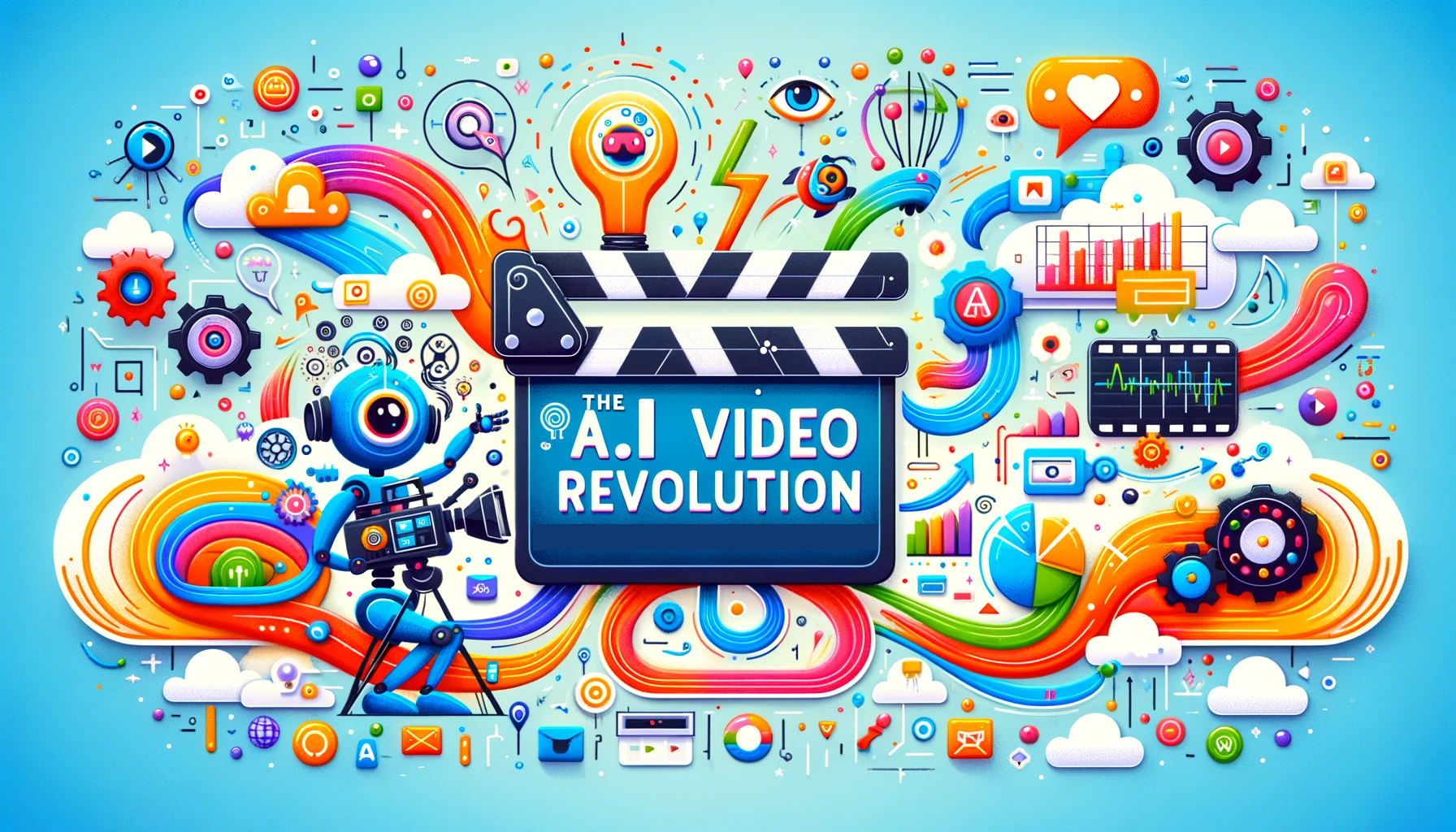
Have you ever wondered how technology is shaping the way businesses engage with their audience and optimize their operations? In today's rapidly evolving digital landscape, one technology stands out as a game-changer: AI-driven video production. In this blog post, we'll explore how AI video is revolutionizing the way businesses tell their stories and operate efficiently. Before diving into the impact of AI video, it's essential to understand the significance of storytelling in business. Brands have long recognized the power of storytelling as a means to connect with their audience on a personal level. In recent years, the integration of AI into video production has taken this concept to new heights. The central challenge businesses face today is the need to create engaging and personalized content that resonates with their audience. Traditional video production methods often fall short in delivering content at the scale and speed demanded by today's digital landscape. This problem calls for innovative solutions. To address this challenge, businesses are turning to AI-driven video production. AI algorithms can quickly analyze vast amounts of data, enabling businesses to gain valuable insights into customer behavior, preferences, and trends. This critical analysis forms the foundation for crafting compelling and tailored content. AI video production offers a range of responses to the challenge of creating engaging content. It enables businesses to automate various aspects of video production, saving time and resources. Additionally, AI can optimize tech stacks, allowing for better data flow and integration across systems. In conclusion, the AI video revolution is reshaping how businesses engage with their audience and operate internally. Embracing AI video production is not merely a trend but a strategic move to stay competitive in the digital age. As AI technology continues to evolve, businesses that harness its power in video production will have a significant advantage. To delve deeper into the AI video revolution and its implications for your business, explore the latest AI and video production technologies. Stay informed about industry trends and consider integrating AI-driven video into your marketing and operational strategies to stay ahead in the digital landscape.

In today's digitally driven world, businesses are constantly seeking innovative ways to engage their audience and gain a competitive edge. One of the most impactful technological advancements in recent years has been the integration of artificial intelligence (AI) into video production. This powerful combination of AI and video is not just a trend; it's a data-driven revolution that can significantly enhance your marketing efforts. Unlocking the Power of Data The foundation of AI video production lies in data—lots of it. Your business accumulates vast amounts of data daily, from customer interactions to website analytics. This data is a goldmine of insights waiting to be unearthed. AI steps in as the key to unlocking this treasure trove. With AI algorithms, you can analyze data at an unprecedented scale and speed. AI can identify patterns, trends, and customer behaviors that may have otherwise remained hidden. This data-driven approach enables you to understand your audience on a deeper level, providing valuable insights into their preferences, pain points, and desires. Personalization at Scale One of the most significant advantages of AI video production is the ability to create personalized content at scale. Traditional video production methods often struggle to deliver tailored content to a diverse audience. AI changes the game by automatically generating personalized video narratives based on individual preferences and behaviors. Imagine sending a video to a potential customer that speaks directly to their needs and interests. AI can analyze their past interactions with your brand and create a video that addresses their specific pain points and offers solutions. This level of personalization not only enhances the customer experience but also drives higher engagement and conversion rates. Efficiency and Speed Time is of the essence in the digital age. Traditional video production can be time-consuming and resource-intensive. AI video production streamlines the process, automating various aspects of content creation. This means you can produce high-quality videos faster and more efficiently. AI can generate video content, edit footage, and even add captions or subtitles—all in a fraction of the time it would take a human team. This efficiency allows your marketing team to stay agile and responsive to rapidly changing market conditions. Data-Driven Decision-Making In the world of marketing, data is king. AI video production not only collects valuable data but also provides actionable insights for decision-making. You can track the performance of your videos in real-time, measuring metrics such as engagement, click-through rates, and conversion rates. This data-driven approach empowers your marketing team to make informed decisions. If a particular video isn't performing as expected, you can quickly pivot and adjust your content strategy. It's a dynamic and iterative process that leads to continuous improvement. Staying Ahead in a Competitive Landscape The digital landscape is fiercely competitive, and businesses that leverage AI video production gain a competitive advantage. By delivering personalized and engaging content, you can stand out from the crowd and capture your audience's attention. Moreover, AI enables you to adapt to changing market trends and consumer behaviors. It's a future-proof strategy that ensures your marketing efforts remain relevant and effective. Conclusion: Embracing the Data-Driven Future In conclusion, AI video production represents a data-driven revolution that enhances your marketing efforts. It leverages the power of data to create personalized content, improves efficiency, and empowers data-driven decision-making. By embracing AI video, your business can stay ahead in a competitive landscape and deliver exceptional value to your audience. As you explore the possibilities of AI video production, remember that the key lies in data. The more you understand your audience, the more effectively you can create content that resonates and drives results. It's a journey toward a data-driven future—one that promises to transform your marketing efforts for the better. To delve deeper into the world of AI video and its impact on marketing, stay tuned for more insights and innovations.

In the age of digital transformation, data has become the lifeblood of business operations. Every interaction, transaction, and engagement generates data, creating a vast repository of information that holds the key to unlocking business potential. But what if we told you that this data could be transformed into compelling video content with the help of artificial intelligence (AI)? Welcome to the world where data becomes video, a realm where AI-generated content takes center stage. The Data-Driven Evolution The digital landscape has witnessed a profound shift from static content to dynamic, personalized experiences. Consumers expect relevant and engaging content tailored to their interests, and businesses are striving to meet these expectations. This is where AI steps in as a game-changer. AI algorithms are adept at analyzing data at scale and identifying patterns. They can decipher customer behaviors, preferences, and trends hidden within the data. This invaluable insight serves as the foundation for creating AI-generated video content that resonates with your audience. The Art of Content Generation AI-driven content generation is a fascinating process that involves the transformation of data into engaging narratives. Here's a glimpse of the magic behind it: Data Ingestion: The process begins with the ingestion of data from various sources—customer interactions, website analytics, and more. This data forms the raw material for content creation. Pattern Recognition: AI algorithms analyze the data to identify patterns, trends, and insights. For example, they can recognize that certain products or services are popular among specific customer segments. Content Generation: Based on the identified patterns, AI generates video content. This can include product recommendations, personalized messages, or informative narratives. Dynamic Personalization: AI goes a step further by dynamically personalizing the content for each viewer. It tailors the video tomatch individual preferences and behaviors. Quality Enhancement: AI ensures that the generated content is of high quality, including factors like video resolution, audio clarity, and visual aesthetics. Delivery: The AI-generated videos are then ready for delivery through various channels, including websites, emails, social media, and more. The Benefits Unveiled The integration of AI-generated video content into your digital strategy brings forth a multitude of benefits: Enhanced Engagement: Personalized videos capture the viewer's attention and keep them engaged. This leads to longer viewing times and increased interaction. Conversion Optimization: AI understands what drives conversions and tailors content to maximize conversion rates. Whether it's a product purchase or signing up for a newsletter, AI has it covered. Efficiency and Scalability: AI can generate a vast volume of video content in a fraction of the time it would take for a human team. This efficiency enables you to scale your content production effortlessly. Data-Backed Decisions: AI provides data-driven insights into content performance. You can track metrics, analyze viewer behavior, and make informed decisions to optimize your content strategy continually. Competitive Edge: By leveraging AI-generated content, you gain a competitive edge in the digital landscape. Your ability to deliver personalized, engaging videos sets you apart from the competition. The Future of Content Creation As businesses continue to evolve in the digital era, AI-generated content is poised to play an increasingly significant role. It's not just about automating content creation; it's about creating experiences that resonate with your audience on a personal level. The journey from data to video is a testament to the power of AI in content creation. It's a journey that promises to redefine how businesses engage with their customers and drive results. As you explore the possibilities of AI-generated content, remember that the magic lies in the data—it's the wellspring of innovation that fuels the content creation engine. Conclusion: Embrace the Transformation In conclusion, AI-generated video content represents a transformative leap in content creation. It harnesses the potential of data to deliver personalized, engaging, and efficient content at scale. As you embark on this journey, embrace the transformation and leverage the magic of AI to captivate your audience and stay ahead in the competitive digital landscape. Incorporating democratized AI technologies plays a critical role in enabling SMEs to enhance their competitive edge, a concept thoroughly explored in 'How Democratized AI Allows Smaller Businesses to Compete' , illustrating the potential for these advancements to level the playing field. The future of content creation has arrived, and it's driven by data, powered by AI, and tailored to your audience's unique preferences. Stay tuned for more insights and innovations as we explore the exciting world of AI-generated content.
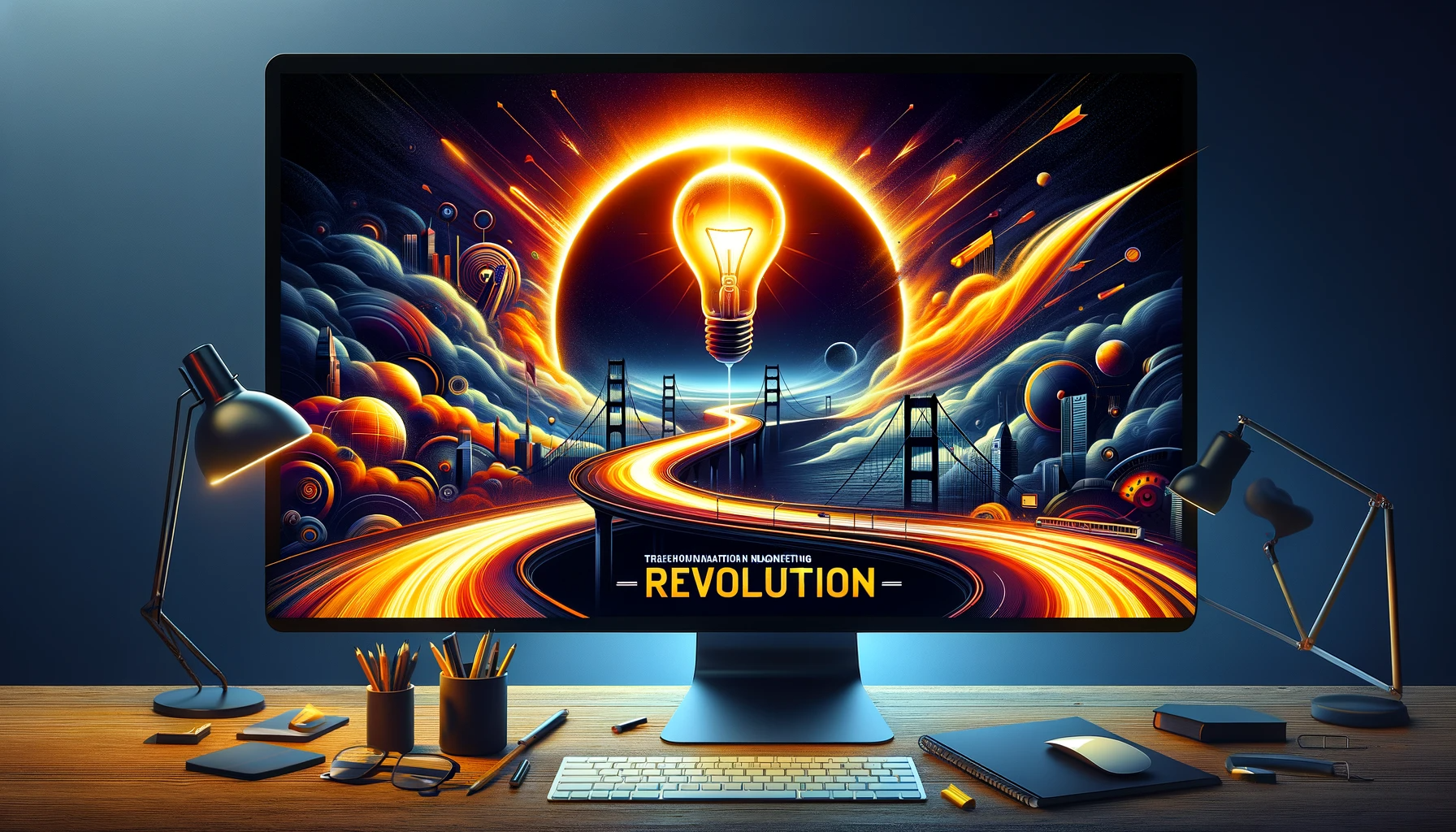
In the ever-evolving landscape of marketing, return on investment (ROI) is a metric that holds immense significance. Businesses invest considerable resources in marketing campaigns, and they want to see tangible results. Enter AI video production, a revolutionary technology that promises to transform marketing investments and redefine the way businesses measure ROI. In this post, we'll delve into the ROI revolution unleashed by AI-powered video production. Before we explore the AI-driven ROI revolution, let's understand the traditional marketing challenge. In the past, businesses relied on conventional marketing methods, such as print advertisements, TV commercials, and billboards. Measuring the effectiveness of these campaigns was often a complex and imprecise task. Marketers struggled to attribute specific results to their marketing spend. The digital age ushered in new marketing avenues, from websites and email marketing to social media advertising. While these digital channels provided more data and insights, measuring ROI remained a challenge. Businesses could track clicks, impressions, and website visits, but connecting these metrics to actual revenue generation was often elusive. The Role of AI Video Production: This is where AI video production steps in as a game-changer. AI-powered video content is designed for engagement and conversion. It tailors messages to individual viewers, making them more likely to take desired actions. But how does this relate to ROI? Personalization and Conversion Optimization AI video content excels in personalization. It understands viewer preferences and behaviors, delivering content that resonates. This personalization leads to higher engagement and conversion rates. When viewers receive content tailored to their interests, they are more likely to make a purchase or take another desired action. Measurable Insights Unlike traditional marketing, AI video production provides measurable insights. Businesses can track not only views and clicks but also conversion events. They can see how many viewers watched a video and then made a purchase or filled out a contact form. These insights provide a clear link between video engagement and ROI. Efficiency in Scaling Campaigns AI enables the efficient scaling of marketing campaigns. It can generate a vast volume of video content quickly and cost-effectively. This means businesses can run multiple targeted campaigns simultaneously, reaching a broader audience and maximizing ROI potential. Data-Driven Decision-Making AI-driven marketing is inherently data-driven. It collects and analyzes vast amounts of data to make real-time decisions. Marketers can see which content performs best, which audiences are most responsive, and where adjustments are needed. This data-driven approach enhances marketing strategies and ROI. Calculating ROI with AI Video Calculating ROI with AI video production is more straightforward than ever. Marketers can attribute specific actions and revenue to individual video campaigns. By comparing the cost of producing and running these campaigns to the revenue generated, they can calculate ROI with precision. Businesses that embrace AI video production gain a competitive edge. They can deliver highly engaging, personalized content that drives results. This competitive advantage extends to industries where ROI is a critical success factor. Conclusion: The ROI Revolution: In conclusion, AI video production represents a revolution in marketing ROI. It empowers businesses to create personalized, engaging content that drives conversions. With measurable insights, efficiency in scaling campaigns, and data-driven decision-making, ROI becomes a clear and attainable metric. As we move forward in the digital era, the ROI revolution continues to evolve. Businesses that harness the power of AI video production are at the forefront of this transformative journey. They not only maximize their marketing investments but also shape the future of marketing ROI. Stay tuned for more insights as we explore the exciting possibilities of AI video production.

Engaging customers is a pivotal challenge for businesses in the digital age. It's not just about selling products or services; it's about fostering relationships that lead to loyalty and advocacy. In this blog post, we'll dive into the world of AI video production and its transformative impact on customer engagement. The Evolution of Customer Engagement Customer engagement has evolved significantly over the years. Gone are the days of one-size-fits-all marketing messages. Customers now expect personalized and relevant interactions with brands. Meeting these expectations is the key to success in today's competitive landscape. The Challenge of Personalization at Scale However, achieving personalized and relevant customer engagement at scale poses a challenge. Traditional methods struggle to keep up with the demand for tailored experiences. This is where AI video production enters the picture. The Power of AI Video Production AI video production represents a paradigm shift in customer engagement. It leverages artificial intelligence to create personalized video content that resonates with individual viewers. By analyzing data on viewer preferences, behaviors, and demographics, AI video crafts content that speaks directly to each person. But it doesn't stop at personalization. AI video introduces interactivity into the equation. Viewers can actively engage with the content, clicking on links, taking quizzes, or exploring product demos. This not only enhances engagement but also provides valuable data on viewer preferences and behaviors. Transforming Customer Support The responses to this technological advancement are multifaceted. Businesses that embrace AI video production gain a significant competitive advantage. They can deliver highly engaging and personalized content that sets them apart in the market. This personalized content guides customers through tailored journeys, from awareness to conversion. Moreover, AI video production isn't limited to marketing. It extends its transformative power to customer support. Interactive tutorial videos and personalized responses enhance the support experience, leading to higher customer satisfaction. Embracing the Future of Customer Engagement In conclusion, AI video production unlocks the potential for unparalleled customer engagement. It's a game-changer in the quest to provide personalized, interactive, and data-driven experiences. Businesses that adopt this technology gain a competitive edge and foster stronger customer relationships. Looking ahead, the future of customer engagement belongs to those who can harness the capabilities of AI video production effectively. It's a dynamic landscape where innovation knows no bounds. As AI continues to evolve, so will the possibilities for enhancing customer engagement. Explore AI Video Production To explore how AI video production can elevate your customer engagement strategies, consider reaching out to our experts for a personalized consultation. Stay tuned for more insights and updates on the latest advancements in AI video technology.

In today's digital age, capturing the attention of your audience and keeping them engaged is a top priority for businesses. Traditional marketing and content creation methods are no longer enough to meet the ever-growing demand for personalized and relevant content. Enter AI video production, a revolutionary technology that has the potential to transform the way businesses connect with their customers and drive growth. To understand the significance of AI video production, let's first take a step back and look at the evolution of customer engagement and content creation. In the past, generic marketing messages were the norm. However, today's consumers expect more—they want content that speaks directly to their interests and needs. The challenge businesses face is clear: How can they create personalized and engaging content at scale? AI video production holds the answer. This technology combines the power of artificial intelligence with video creation to produce dynamic and tailored content that resonates with individuals on a personal level. AI video production represents a paradigm shift in content creation. By utilizing AI algorithms, businesses can analyze user data, behaviors, and preferences to craft videos that connect with viewers on a profound level. No longer are marketing messages one-size-fits-all; AI enables hyper-personalization that truly engages the audience. Businesses that have embraced AI video production have experienced remarkable results. Engagement rates have skyrocketed as viewers connect with content that addresses their specific interests and needs. Furthermore, the interactive nature of AI video provides valuable insights into consumer behaviors, allowing for continuous improvement and optimization of content strategies. Looking ahead, the role of AI video production in business growth is poised to expand even further. Ongoing advancements in AI technology open up limitless possibilities. From e-commerce to customer support, AI video is becoming a cornerstone of modern business strategies, helping companies thrive in the digital landscape. If you're a business aiming to stay ahead and unlock the potential of AI video production for growth, now is the time to explore this transformative technology. Get in touch with our experts for a personalized consultation and discover how AI video can revolutionize your content strategy. Stay tuned for more insights on the latest trends and innovations in AI video technology.
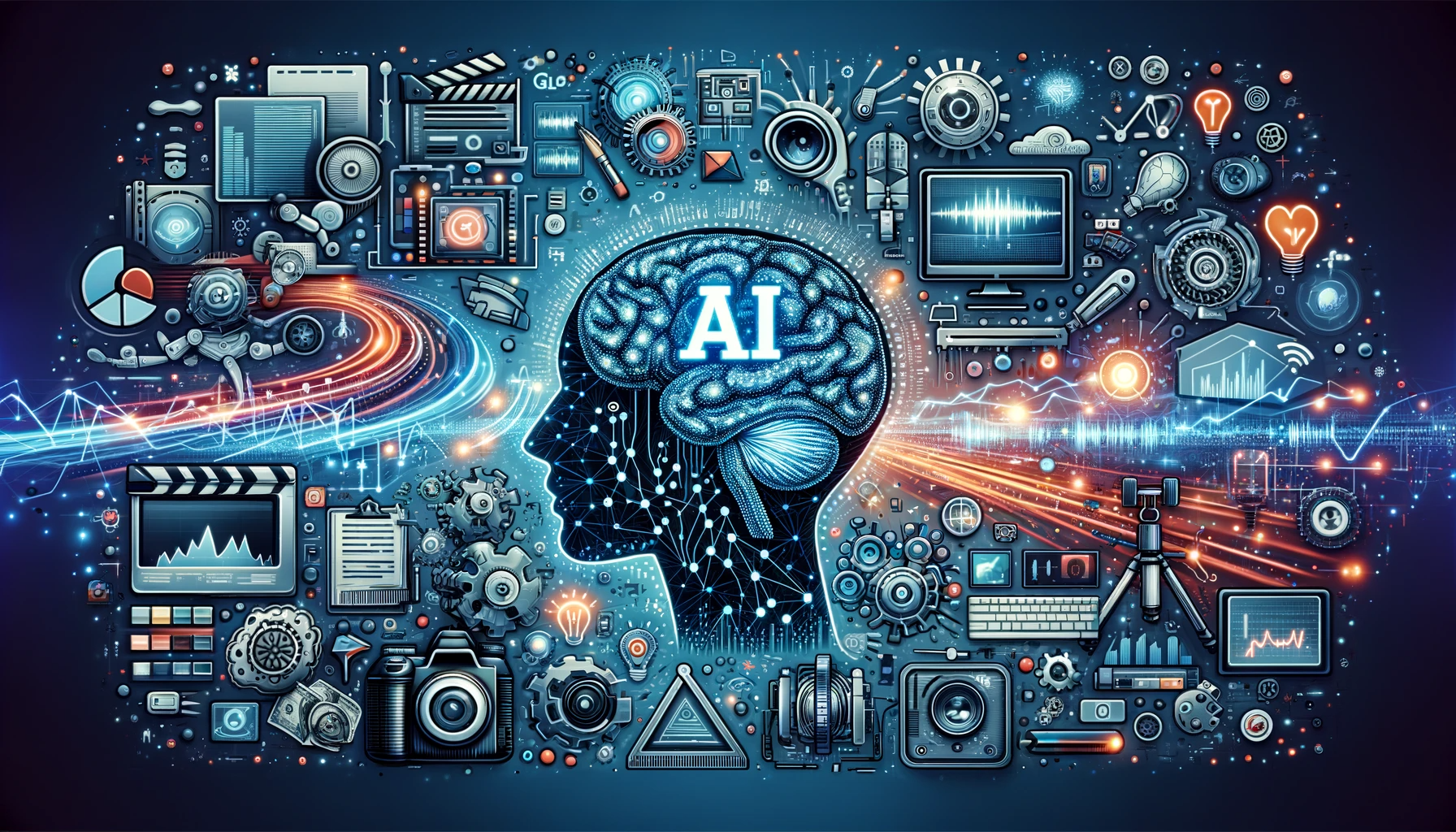
In the fast-paced digital landscape of today, businesses face a pivotal question: How can they create content that not only captures the attention of their audience but also resonates with them on a deeply personal level? The answer lies in the transformative power of AI video production, a game-changer in the world of content creation. Think about the content you encounter daily—whether it's on social media, websites, or emails. Now imagine if that content could adapt to your unique preferences, interests, and behaviors. That's precisely what AI video production enables. To truly appreciate the impact of AI video, let's rewind a bit. Traditional content creation methods often involve crafting one-size-fits-all messages, hoping they'll strike a chord with the diverse audience. However, this approach has its limitations. It's challenging to maintain engagement when your audience receives generic content that doesn't speak to their specific needs. Enter the problem statement: Businesses struggle to create data-driven content at scale. The wealth of data available is both a blessing and a challenge. How can organizations harness this data to craft content that resonates? This is where AI video steps in as a game-changer. AI video production leverages sophisticated algorithms to analyze data, turning it into personalized and engaging content. It's like having a personal content creator who understands each viewer's preferences. This technology takes your data and transforms it into dynamic videos that feel tailor-made for each individual. The real magic happens when we look at how businesses have responded to this transformation. Companies across industries are embracing AI video to create content that speaks directly to their audience. Engagement rates soar as viewers connect with content that feels like it was made just for them. Consider e-commerce, where AI video personalizes product recommendations, or customer support, where interactive AI videos guide users through solutions. These are real-world examples of how AI video is revolutionizing content creation and customer engagement. Looking ahead, the future of AI video is boundless. As AI technology continues to advance, so do the possibilities for content creation. From marketing to training, AI video is becoming a cornerstone of modern business strategies, unlocking growth opportunities in the digital era. If you're a business leader looking to stay ahead of the curve, now is the time to explore AI video solutions. Connect with our experts for a personalized consultation and discover how AI video can transform your content strategy. Stay tuned for more insights on the latest trends and innovations in AI video technology.

In the ever-evolving landscape of digital business, delivering an exceptional customer experience is no longer a choice; it's a necessity. Customers now expect interactions that are not just personalized but also anticipate their needs. To meet these expectations, companies are turning to AI video, a groundbreaking technology that is reshaping how businesses engage with their customers. Picture this scenario: You receive a video message from a company, and it doesn't just greet you by name but also offers product recommendations tailored precisely to your preferences. This level of personalization is no longer a dream but a reality, thanks to AI video. In this blog post, we'll dive deep into the profound impact of AI video on the customer experience landscape. The Challenge: Personalization at Scale In the past, providing personalized experiences at scale was a monumental challenge for businesses. Customers often found themselves inundated with generic content that failed to resonate. The quest to bridge this gap led to the emergence of AI video. AI video production has opened up new possibilities for businesses seeking to elevate their customer interactions. Through the fusion of AI algorithms and data analytics, companies can now craft video content that is uniquely tailored to each individual. Real-World Success Stories Let's take a closer look at some real-world success stories where AI video has transformed customer experiences: E-Commerce Personalization: Leading e-commerce giants have harnessed AI video to offer personalized shopping experiences. Imagine receiving a video showcasing products that align perfectly with your preferences and browsing history. Interactive Customer Support: Forward-thinking customer support teams are using AI video to provide step-by-step video guidance. Whether it's troubleshooting a technical issue or assembling a product, customers receive interactive and personalized assistance. The Future Landscape As technology continues its rapid evolution, AI video is poised to play an even more pivotal role in shaping customer experiences. The ability to deliver highly tailored content and personalized interactions is becoming a standard expectation across various industries. In closing, AI video is not just a technological advancement; it's a game-changer for businesses looking to forge deeper connections with their customers. By harnessing the power of AI video, companies can unlock their full potential and offer customer experiences that truly stand out in today's fiercely competitive landscape. Are you ready to transform your customer experience through AI video? Reach out to our experts for a personalized consultation and discover how AI video can propel your business to new heights.
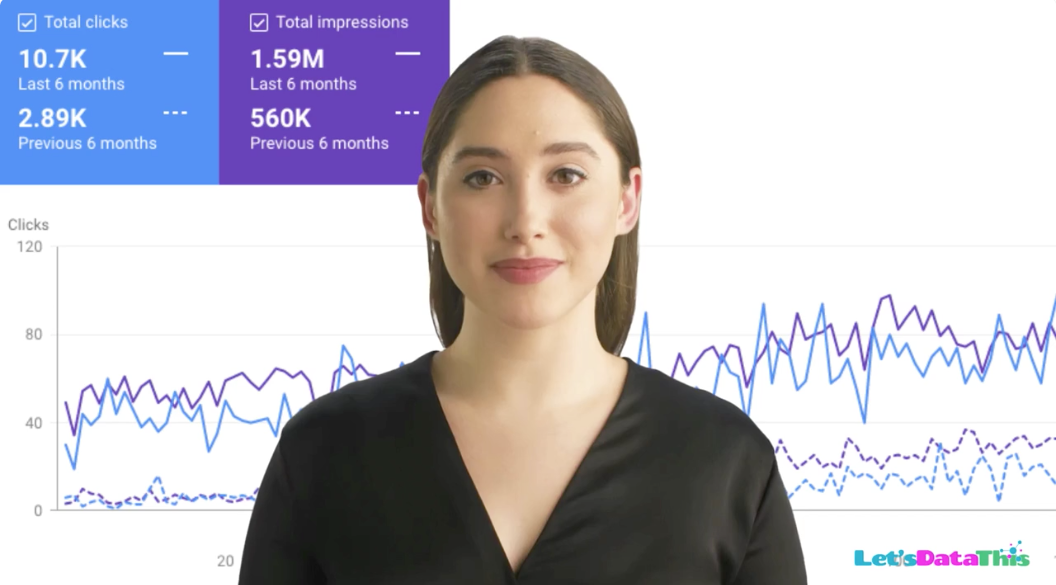
Discover how SEMrush can help your business with digital transformation. With powerful tools for keyword research, competitor analysis, technical optimization, and content creation, SEMrush can streamline your digital marketing efforts and drive more traffic to your website. Businesses that use SEMrush have reported significant increases in organic traffic and engagement. Try SEMrush today and stay ahead of the competition in the digital world.

In the ever-evolving landscape of business, one term has risen to prominence and become a driving force behind growth, efficiency, and innovation—digital transformation. For Small and Medium-sized Businesses (SMBs), embracing digital transformation is not just a choice; it's a necessity in a world where technology continually reshapes the rules of the game. But where does one begin on this transformative journey, and how can SMBs navigate the complex terrain of digitalization effectively? In this era of unprecedented digital possibilities, we present a roadmap tailored to the unique needs of SMBs. Digital transformation involves the integration of digital technologies into all aspects of a business, with the potential to enhance efficiency, productivity, and ultimately, growth. Throughout this journey, we'll explore the essential steps that SMBs should take to embark on a successful digital transformation. From defining clear objectives to fostering a digital culture, each step plays a crucial role in reshaping the way SMBs operate in the digital age. Let's delve into the intricacies of digital transformation for SMBs and uncover the path to harnessing technology as a catalyst for success. Step 1: Define Clear Objectives The journey of digital transformation begins with a clear vision. Identify the key areas of your SMB that stand to benefit from digitalization. This could encompass various aspects, including sales, marketing, customer service, and supply chain management. Once these areas are identified, define specific objectives that digital transformation should aim to achieve in each one. For example, in sales, your objective might be to increase lead conversion rates through improved customer relationship management. In marketing, it could be to enhance customer targeting and personalization. By having well-defined objectives, you'll have a roadmap for where digital transformation should take your business. Step 2: Assess the Current State Before embarking on the digital transformation journey, it's essential to assess your business's current digital landscape. Evaluate your existing infrastructure, systems, and processes. Identify areas of inefficiency, bottlenecks, potential security risks, and any other pain points that may hinder progress. This assessment will serve as a benchmark for measuring the impact of digital transformation later on. It will also help you prioritize which areas require immediate attention. Step 3: Choose the Right Technology Selecting the right technology stack is a pivotal decision in your digital transformation journey. It's crucial to align your technology choices with your business objectives and the existing infrastructure. Consider options like cloud computing, data analytics, artificial intelligence, and customer relationship management (CRM) software. The key is to choose technologies that seamlessly integrate with your current systems and empower you to achieve your defined objectives. Conduct thorough research and seek expert guidance to make informed decisions. Step 4: Develop an Implementation Plan Creating a robust implementation plan is essential for a smooth transition. Define clear timelines, allocate necessary resources, and outline the steps involved in deploying the chosen technologies. Ensure that you have a strategy for training and development to equip your employees with the skills they need. Step 5: Embrace Agile Methodologies In today's rapidly changing business environment, flexibility is paramount. Implement agile methodologies that encourage iterative development and continuous improvement. This approach allows you to adapt to changes in the business landscape and fine-tune your digital transformation efforts as needed. Step 6: Cultivate a Digital Culture Digital transformation isn't just about technology; it's a cultural shift. Foster a digital culture within your organization where employees are enthusiastic about embracing new technologies and innovation. Provide ongoing training and support to empower your workforce to work effectively with digital tools. Step 7: Monitor and Evaluate The journey doesn't end with implementation—it's an ongoing process. Regularly monitor and evaluate the impact of digital transformation on your business. Identify areas of success, track key performance indicators, and pinpoint areas that require improvement. This continuous assessment ensures that your digital transformation remains aligned with your objectives and responsive to changing market dynamics. Remember, digital transformation is a dynamic journey that requires adaptability, learning, and a commitment to innovation. By following these steps, SMBs can successfully navigate the path to improved efficiency, productivity, and growth in the digital era. Digital transformation is not a destination but a continuous journey—a voyage into the future of business. For SMBs, it offers the promise of increased efficiency, heightened productivity, and unprecedented growth potential. The steps outlined here serve as a blueprint, guiding SMBs through the complex landscape of digitalization. By defining clear objectives, assessing the current state, selecting the right technology, and embracing agile methodologies, SMBs can lay the foundation for a successful digital transformation. Cultivating a digital culture within the organization further ensures that employees are equipped with the skills and mindset needed to thrive in the digital era. As SMBs navigate this transformative journey, they must remember that digital transformation is an ongoing process. Regular monitoring and evaluation are essential to adapt to changing market dynamics and ensure that the digital transformation remains aligned with the overarching business objectives. In the digital age, SMBs have the opportunity to not only survive but thrive. With the right approach, they can harness the power of technology to reshape their future and drive their businesses to new heights of success.

Google's Universal Analytics has been the backbone of many businesses' digital analytics strategy for years. It has allowed businesses to track user behavior across multiple devices, identify trends and patterns, and optimize their online presence for better engagement and conversions. However, in October 2022, Google announced that it would be retiring Universal Analytics in favor of Google Analytics 4 (GA4). This announcement has left many businesses wondering if they are ready for the change. The short answer is no. Many businesses are not prepared for the transition from Universal Analytics to GA4. GA4 represents a significant shift in the way digital analytics works. It introduces new features and a new data model that can be overwhelming for businesses that are not used to it. However, with the right preparation and guidance, businesses can make a smooth transition to GA4 and continue to leverage the power of digital analytics. What is Google Analytics 4? Google Analytics 4 is the next generation of Google's analytics platform. It is designed to provide businesses with a more comprehensive understanding of user behavior across devices and channels. It uses a new data model that is event-driven and allows businesses to collect more granular data about user interactions with their website or app. One of the key benefits of GA4 is that it is designed to be more privacy-centric. It allows businesses to collect data without using cookies, which is becoming increasingly important in the face of changing data privacy laws. Why is Universal Analytics going away? Google is retiring Universal Analytics because it is outdated and no longer meets the needs of modern businesses. Universal Analytics was launched in 2012, and since then, the digital landscape has changed significantly. The rise of mobile devices and social media platforms, as well as changing data privacy laws, means that businesses need a more advanced analytics platform to stay ahead of the game. GA4 is designed to meet these needs. It provides businesses with a more comprehensive understanding of user behavior, including how users interact with their website or app and how they move between devices and channels.

How do you choose the right inbound marketing agency? Digital marketers must be experts in two worlds: the precision data world and the creative persuasion realm. This is just as true for development teams as it is for digital agencies and executives who work with marketing. Regardless of where you start, rest assured for the future; you need to focus on bridging the gap between those two worlds. There is an exponential growth in digital technology solutions built to reach specific marketing goals. These can be leveraged, and integrated with the Assure Clean Data We ensure your marketing data collection tools run smoothly and pull in clean data. Your hardware and software must fire on all cylinders to glean the insights your company needs to truly understand your audience. Our deep technical audits demonstrate what needs to happen next for improved data quality management. There are millions of stories about your company hidden in the data. We’ll work with you to tease out what you need to know and make a plan for you to be more extensive whenever you’re ready. Make Accurate Decisions Data audits determine the underlying structure of your future digital marketing campaigns. Our goal is to see your marketers and developers work as a team on projects ranging from intelligent marketing campaigns to digital online assets. When you know you’re working with the right data, your team can make informed decisions about what motivates existing customers and potential prospects in new markets. This is how you’ll achieve better ROI on all your digital marketing ventures. Maximize Digital Tools What do you want to achieve? Whether you want to maximize organic rankings, or ensure your core metrics are centered on PPC, tracking and conversions, you can set up your campaigns for success. These factors are just pieces of the bigger picture. We’ll help you overcome your immediate roadblocks and show you the best path forward from there. Beyond just helping you gain the most value from tools like Google Analytics, we can analyze the overall quality and accessibility of your content to make sure it reaches your preferred customer base. Our extensive competitive analysis processes will rank your current efforts against your top five competitors in terms of SEO success levels, the efficiency of your PPC and a variety of social media metrics. However you’re working now, you’ll find we can show you how to achieve more profitability. Have an existing CRM, Email Marketing Platform, or Marketing Automation Suite? We help you leverage your toolset, optimize processes, and improve the quality of your content and campaigns. As inbound marketing consultants, with an affinity for marketing technologies, we help solve challenges that come along with defining processes, determining team roles and accountability, as well as developing and executing multi-channel/cross-device digital marketing campaigns. At the end of the day, here’s what we’ll be doing together: Maximizing conversions from your websites, emails, and apps. Brainstorming new ideas and interactive digital experiences that would help drive newer and/or more conversions. Determining sources for the traffic that is most likely to convert. Get that traffic to convert—and to come back. Capture data to tell the story from engagement to ROI. Optimize your digital marketing and online sales processes, ultimately aligning your sales and marketing strategies/teams. We will examine everything related to the foundation of any business cementing their business’ place online. Here’s what we touch: Conversion Goals — online sales, form fills, phone calls, email drip campaigns, etc. Websites Apps Videos SEO Content Paid Search Landing Pages Social Media Display Advertising Programmatic Advertising Email Nurturing & Drip Campaigns Marketing Automation ROI Tracking with Analytics
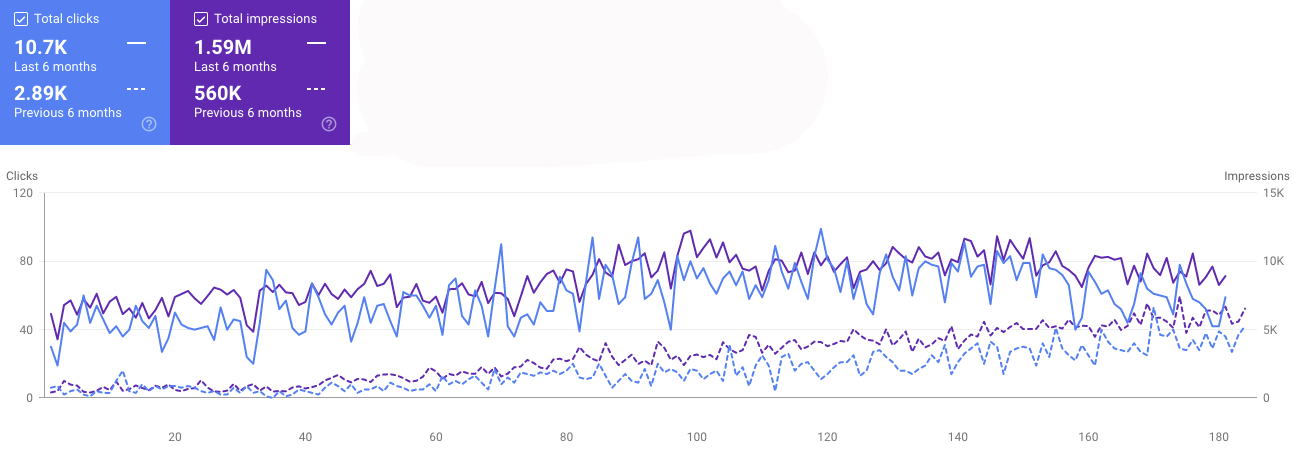
It can be difficult to know if you've resolved all technical SEO factors affecting your organic rankings, but there are several steps you can take to help ensure that you have addressed as many issues as possible: Conduct a comprehensive technical SEO audit: A technical SEO audit can help identify issues with your website's technical setup, such as crawl errors, broken links, duplicate content, and slow page load times. Use Google Search Console: Google Search Console can help you identify issues with your website's indexing, crawlability, and performance in search results. Make sure to monitor the console regularly to catch and resolve issues as soon as possible. Check your website's mobile responsiveness: With the majority of web traffic now coming from mobile devices, it's important to ensure that your website is fully responsive and optimized for mobile users. Analyze your website's page speed: Slow page load times can negatively impact user experience and search rankings. Use tools like Google's PageSpeed Insights or GTmetrix to identify and address page speed issues. Monitor your website's backlink profile: High-quality backlinks can boost your website's authority and rankings, but low-quality or spammy links can hurt your site's reputation. Use tools like Ahrefs or SEMrush to monitor your website's backlink profile and disavow any harmful links. By regularly conducting technical SEO audits and monitoring your website's performance, you can help ensure that you've addressed all technical SEO factors affecting your organic rankings. Technical SEO that audits provide you with complete and holistic views of all technical and qualitative factors that affect your search engine rankings — positions and quantity. Your SEO strategy should put you high enough in search rankings that you’re seen regularly by your preferred customers. How well is your SEO achieving all of its goals? Could it be doing a better job in some areas? Don’t wonder. Get answers. Our Advanced Technical SEO Audit gives you a comprehensive tool for examining all factors that affect your rankings, organic traffic, and potential business. We make sure every page on your site is loading rapidly and operating smoothly. We’ll also test what your social signals and local reviews are doing for your rankings. Visit our Advanced Technical SEO Audit page to find out more about the metrics covered in this audit, and to see a detailed timeline for the month-long process. Are you wondering if your SEO Consultant/Agency is doing everything they say and can? Or do you need to provide your team with an actionable SEO audit that reports on all factors that affect your rankings and organic traffic and opportunities. Persuasive Data provides you with complete and comprehensive technical audits that tell you if your SEO program is working for you or against you. Automated auditors and SEO tools will often only crawl a single page, which is like the first sip of our morning coffee! Our goal is to provide you with a comprehensive technical SEO audit for your website that will tell your developers and your SEO team exactly what is right, and what is wrong with your technical SEO, and the related qualitative factors. What are the benefits of a Technical SEO Audit? Make Your Website Faster! Give your developers a 100% view of all factors that affect site load time — a major SEO factor. Faster sites make for happier users too! Ensure Accessibility by Search Engines and People! It is imperative that your website and content is able to accessed by search engines and your users. Websites with proper accessibility are better indexed, used, and shared. Determine Any SEO Health Issues! It’s very good to know if any health-related SEO issues are hurting your organic rankings and traffic. You will know what needs to be done and we will provide direction and options for resolution. Brand Congruence & Channel Attribution SEO in today’s Internet relies much less on links and meta tags. Search engines now look to social media, local networks, and reviews for ranking signals. Know if social and local are working for you, or against you. What are the sections of a technical SEO audit? Server Side Issues for Developers All technical server-side issues that affect site speed and page load time and user-experience. Websites need to load content within 2 seconds. While we focus on this value for search engines, it’s really a user value. Think about it, how many times do wait more than 4 or 5 seconds for a site to load, before you jump ship? Faster sites make for more traffic and rankings. The repair report will breakdown all factors for your developers, so they can resolve all issues with an agile approach. We also provide optimized images for all images on the site that need to be reduced in file size. This will save your team hours. We can also provide you with an interactive dashboard that will chart the resolution of discovered issues on a daily basis. Website Accessibility Audit Search engine accessibility is the means by which a search engine can access, and then index, your content so it can rank. This also has a direct correlation with the human experience as well. A fully accessible site is one that allows all potential users, equal access to the the content that satisfies their needs. We analyze the technical and information architecture of your site. As well as the related SEO factors. You receive overall recommendations and action items based on discovery. Domain Authority Analysis If you know what PageRank is, then Domain Authority should be easy to understand. This authoritative value given to a website can inform us as to the quality of the site, in the ‘eyes’ of search engines. These are qualitative factors, as well as trust-based factors, that are a part of the algorithmic calculation. This value can be used to explain the health of your site, which means the health of your rankings. The higher your domain authority, you will see more rankings with top ranking positions. From our research, we will point out what could be hurting you and what you should do to resolve the issue(s). User Experience (Usability) Analysis The usability of your website is also an organic search ranking factor. This is a close relative to accessibility issues, however, this is directly related to how usable your site is for your visitor. Did you know that that ever-so-popular homepage slider is actually ignored by users most of the time? It creates a waste for space, and pushes main content below the fold. Mobile usability warnings are now also being sent to website owners via Webmaster Tools (rebranded to ‘Search Console’ by Google in July 2015). We explore the major usability factors and provide you with recommendations on improving any and all issues we uncover. Onpage SEO Factors Audit Of the 200+ (unknown) factors that go into Google’s search algorithm, we identify nearly 75 factors related to the content on your site. Each are analyzed to provide you with recommendations and action items. These are the factors that relate to how your content is being indexed, displayed, consumed, and shared. This also dives into next generation SEO factors that are the basis of evolving search engines and content features. Offpage SEO Factors Audit Like the Onpage factors, these Offpage/Offsite factors can hurt and help your organic rankings. These include values related to your competitors, brand, and market share. Internal & External Link Health Analysis While links are now slightly less important in the ranking algorithm, than in years past, they are still invaluable. Links signal value, trust, use, and authority. And where they can lift you into the sky, if manipulated, bad links can bury your site. We evaluate your historical links, and the past year, to determine your link health. You will either be assured, or warned. Either way, we will paint a picture for you to be able to visualize your link landscape, so you can make accurate and informed decisions on any recommended actions. Local Networks SEO Audit Whether you are a localized business, or an international brand, the consistency of your Name, Address, and Phone Number on profiles across Local Networks are a search engine ranking value. This helps search engines link data points together, and thus, those that are optimized see rewards with higher rankings. Further, reviews and ratings on these networks are very important signals for the types of sites people are likely to want to see ranking in their search results. We provide you with an audit of more than 50 local networks, along with actionable recommendations. Social Media & SEO Analysis Social signals are getting up there in value with linking signals. We look at your major social profiles to determine health, and if you are leveraging them as much as you should be, as they relate to supporting your organic rankings. This includes factors on your website, as well as things you are able to actively control on the social networks themselves.

To make sure you are using new technology to identify and track your leads through your conversion funnels, follow these steps: Choose the right tools: There are a variety of tools available to track leads through your conversion funnels, including Google Analytics, marketing automation software, customer relationship management (CRM) tools, and more. Research and select the tools that best fit your business needs and budget. Set up tracking codes: Make sure you have tracking codes properly set up on your website and landing pages to capture data on user behavior, such as clicks, form submissions, and purchases. Define your conversion funnel: Determine the stages of your conversion funnel and the key performance indicators (KPIs) you will track at each stage, such as bounce rates, time on site, and conversion rates. Implement lead scoring: Use lead scoring techniques to assign point values to each lead based on their behavior and level of engagement with your content. This will help you prioritize your leads and focus your efforts on those most likely to convert. Monitor and analyze your data: Regularly review your tracking data and analyze your results to identify areas of your conversion funnel that need improvement. Use this information to optimize your website and marketing campaigns and improve your overall conversion rate. By following these steps, you can leverage new technology to track and optimize your leads through your conversion funnel, leading to more successful conversions and improved business results. Gain powerful information from your audience so that you can make the most effective decisions about your next steps. We provide a deep, thorough analysis of the accuracy and tracking practice of your conversion funnels as we help you answer critical questions about your conversion-rate optimization strategy. Are you using the right types of conversions? Are you leveraging the most effective and powerful tools available to track them? We take a look at what you currently have in place and identify any issues with usability to correct potential setbacks and uncover opportunities for improved conversion funnels. This qualitative analysis includes user-video tests and insights from your target audience to give you a clear picture of what you need to do to promote lasting growth. What are the benefits of a conversion funnel audit? Attract Users and Get the to Convert. The right conversions, in the right place, at the right time, with the right format will drive continual lift in qualified conversions. Don't Miss Conversion Opportunities! Placement, placement, placement. It’s one of the 4 P’s that matters in facilitating user engagement on your digital properties. Don’t make them miss! Discover Issues and Improve Conversions! Ensure your intended conversions are working as you need and that you are fully leveraging your analytics and marketing technology solutions. Facilitate Conversions Across All Device Types. It’s imperative that your users are provided with the same ease of use and ability to engage in their conversion funnel, regardless of their device type. What are the sections of a conversion funnel audit? Marketing Technology Analysis Usability Best Practices Conversion Types Conversions by Device Funnel Analysis Engagement Analysis Missed Opportunities Recommendations
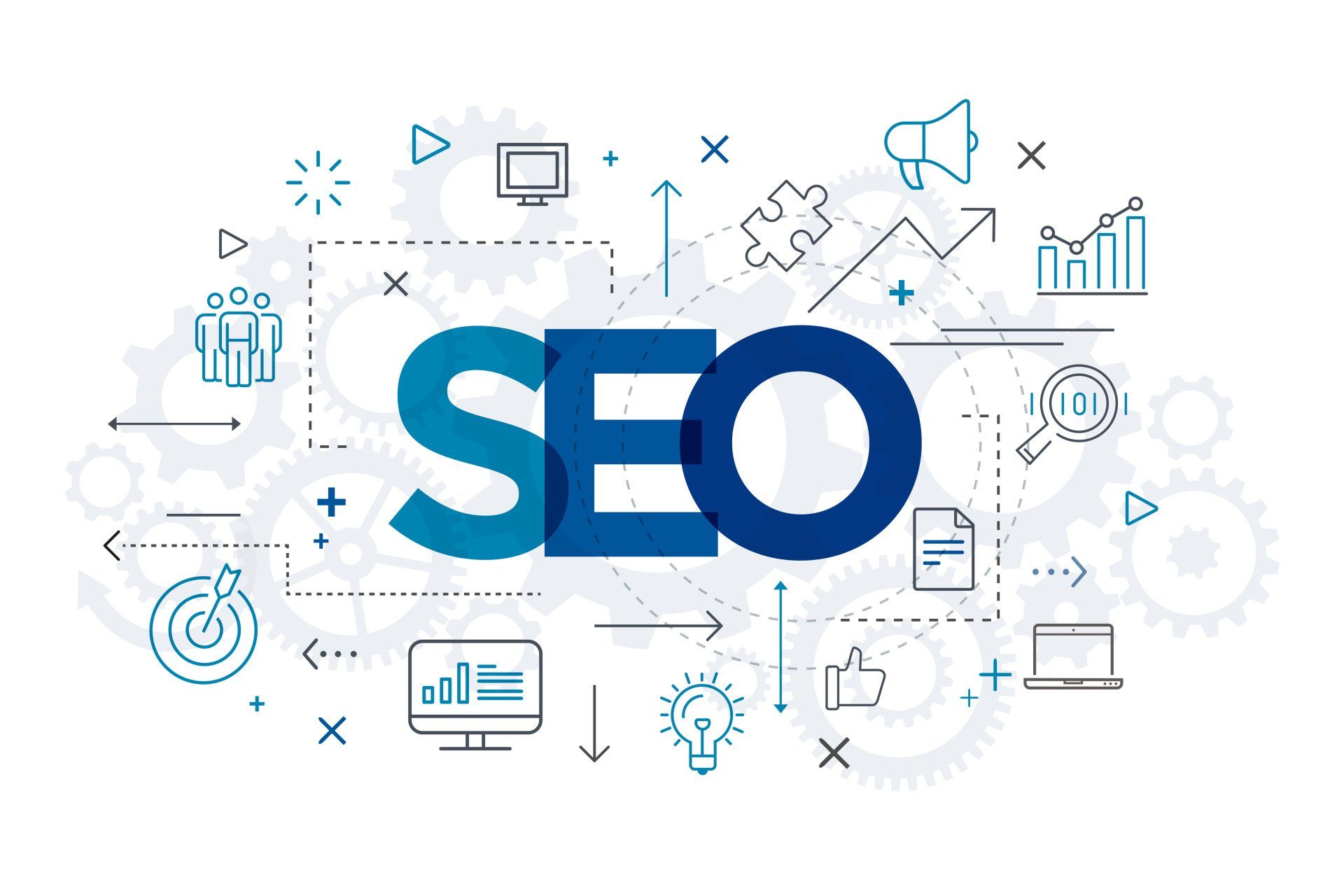
By conducting a thorough competitive analysis and leveraging digital tools and resources, you can gain a deeper understanding of what your competitors are doing to attract and retain customers. This can help you identify new opportunities and improve your own marketing and sales strategies to better meet the needs of your target audience. You need to know what your competitors are doing right — and what they’re doing wrong — so that you’re sure to focus your own efforts properly. You need to do a thorough search-engine marketing, or “SEM,” analysis of your competitors’ practices to make recommendations on how you can improve on their strategies. Plus, you need to identify their missed opportunities, which are places where you can fill in the gaps and gain market share. To make sure you are using new technology to identify and track your leads through your conversion funnels, follow these steps: Choose the right tools: There are a variety of tools available to track leads through your conversion funnels, including Google Analytics, marketing automation software, customer relationship management (CRM) tools, and more. Research and select the tools that best fit your business needs and budget. Set up tracking codes: Make sure you have tracking codes properly set up on your website and landing pages to capture data on user behavior, such as clicks, form submissions, and purchases. Define your conversion funnel: Determine the stages of your conversion funnel and the key performance indicators (KPIs) you will track at each stage, such as bounce rates, time on site, and conversion rates. Implement lead scoring: Use lead scoring techniques to assign point values to each lead based on their behavior and level of engagement with your content. This will help you prioritize your leads and focus your efforts on those most likely to convert. Monitor and analyze your data: Regularly review your tracking data and analyze your results to identify areas of your conversion funnel that need improvement. Use this information to optimize your website and marketing campaigns and improve your overall conversion rate. By following these steps, you can leverage new technology to track and optimize your leads through your conversion funnel, leading to more successful conversions and improved business results. Look at your competitors’ keyword strengths, social-media presence and how much they spend on pay-per-click, or PPC, advertising. An effective audit helps you determine where you stand in the market, where your competitor stands and what you can do to gain a winning edge in your search-engine marketing efforts. What are the benefits of a Competitor SEM Audit? Know What Your Competitors Are Doing... Discover the gaps that you can fill. See what they are doing right, and wrong, and make informed decisions. See What & Where They Invest. Gain insight on how much they are investing in their SEM efforts, and across which search and social networks. Take Advantage of their Misses... Their misfirings become your ammunition in these competitive spaces. By identifying where they cut corners, we can build a foundation. Determine Your Market Share & Untapped Opportunities! Understand your market size and potential, fully! See where you are and where your customers are looking, for you and your competitors. What are the sections of a Competitor SEM Audit? Consider a SWOT analysis for SEO... Their Paid (PPC) Efforts... Their Social Presence... Website Comparisons Content Comparisons
DON'T MISS A DATA THING
We promise to only send you the good stuff. No spam.



